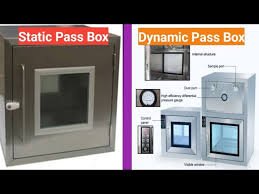Difference Between Dynamic and Static Pass Box

Fungus in Pharmaceutical Cleanrooms: Types, Origins, and Decontamination
1. Introduction
Fungal contamination in cleanrooms is a major risk to sterile product manufacturing, since fungal spores are ubiquitous, resistant, and can survive in harsh conditions. Even low levels can compromise sterility assurance, leading to batch rejection, deviations, or regulatory findings.
2. Common Types of Fungi Found in Cleanrooms
-
Aspergillus spp. (e.g., A. niger, A. fumigatus) – common airborne spores.
-
Penicillium spp. – spore formers, thrive on damp surfaces.
-
Cladosporium spp. – often from outdoor air; dark green/black colonies.
-
Alternaria spp. – found in dust, soil, HVAC inlets.
-
Fusarium spp. – soil/plant origin; occasionally isolated in water systems.
-
Candida spp. – yeasts, can originate from personnel (skin, mucosa).
3. Origins / Sources of Fungal Contamination
-
Personnel – skin, hair, improper gowning, poor aseptic practices.
-
HVAC systems – poorly maintained AHUs, damp ducts, inadequate filtration.
-
Raw materials & packaging – especially from plant-based sources.
-
Water leaks/condensation – stagnant water promotes fungal growth.
-
Cleaning tools & disinfectants – contaminated mops, reusable cloths.
-
External environment – ingress through poorly sealed areas, doors, or uncontrolled transfers.
4. Risks
-
Fungal spores can survive routine disinfectants.
-
Can form biofilms in drains, walls, or ceilings.
-
Cause OOS (Out of Specification) environmental results, regulatory citations, and potential product recalls if contamination enters sterile batches.
5. Decontamination and Control Measures
a. Preventive Actions
-
HVAC Maintenance: Regular HEPA filter integrity testing, duct cleaning, humidity control (<60%).
-
Cleaning & Disinfection:
-
Rotate disinfectants with sporocidal agents (e.g., hydrogen peroxide, peracetic acid, chlorine dioxide).
-
Frequent cleaning of corners, ceilings, walls, and drains.
-
-
Personnel Training: Gowning, aseptic handling, minimizing movement.
-
Raw Material Control: Incoming material inspection, controlled transfer through pass boxes.
-
Moisture Control: Prevent leaks, condensation, damp areas.
b. Corrective Actions (if fungus detected)
-
Identify fungal isolate (genus/species).
-
Perform root cause analysis – source tracing (HVAC, water, operators, raw materials).
-
Quarantine affected areas.
-
Deep cleaning & fumigation with sporicidal agents.
-
Increase environmental monitoring frequency until issue is under control.
-
Revise SOPs, retrain personnel, implement CAPA.
c. Long-term Measures
-
Continuous EM trend analysis.
-
Periodic microbiological mapping of cleanroom.
-
Preventive maintenance of HVAC and drains.
-
Disinfectant efficacy validation (including fungicidal/sporicidal claims).
✅ In short:
The most common fungi in cleanrooms include Aspergillus, Penicillium, Cladosporium, and Alternaria. They typically originate from personnel, HVAC, raw materials, or moisture issues. Control requires a preventive + corrective approach: robust HVAC maintenance, moisture control, routine use of sporicidal disinfectants, effective cleaning, and personnel training.
🎓 Discover one of the best Pharmaceutical Microbiology course available —click below to explore the course that’s shaping future Microbiology course skills.

